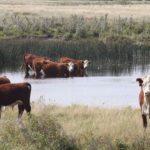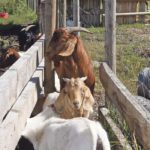Johne’s disease is a relatively easy disease to diagnose in an individual cow, either through clinical signs or at post mortem. The characteristic symptoms of progressive weight loss and chronic watery diarrhea are easily identifiable. This slowly developing bacterial infection is most often contracted by very young calves and may not show clinical signs until […] Read more
Stories by John Campbell, DVM, DVSC
Do killed BVD vaccines provide fetal protection?
Bovine viral diarrhea virus is one of the most important viruses affecting the North American cattle industry. The virus can cause devastating economic losses in terms of infertility, abortions, stillbirths and calf deaths. As a result, it is not surprising that it is an important and vital component of any vaccination strategy in cow-calf herds […] Read more
Pinkeye vaccination study questions its effectiveness
With summer around the corner, pinkeye treatment will be an issue many cow-calf producers may have to deal with. Studies from the United States have estimated that 17 percent of beef cattle herds are infected annually with pinkeye. Cattle with pinkeye (or conjunctivitis) will have an inflammation of the soft tissues surrounding the eye and […] Read more
Mycoplasma bovis infectionsnot understood in beef calves
About this time last year, I had an opportunity to visit New Zealand to attend a conference on animal health surveillance. I enjoyed touring the beautiful countryside and seeing the large numbers of farms mostly populated with sheep and dairy cows. Lately, a lot of news is coming from the veterinary community in New Zealand […] Read more

Copper deficiency a problem when sulfates are high
Last summer, we had significant water quality issues in parts of Saskatchewan and Alberta that affected the cattle population. The low levels of rainfall and the high temperatures of the summer resulted in the concentration of salts in dugouts, which resulted in very poor water quality, largely due to high levels of sulfates in the […] Read more
Purchased colostrum can be a significant biosecurity risk
Adequate colostrum intake is essential to get a calf off to a good start. Newborn calves are born with virtually no immunity of their own. The placenta of the cow does not allow antibodies to pass from the mother to the calf during pregnancy. This means that the calf must receive its initial immunity from […] Read more
Pain control during castration considered the right thing to do
Castration is one of the most common painful animal management procedures we do in the beef industry. As of Jan. 1, the industry’s revised code of practice for care and handling of beef cattle has a new requirement that stipulates pain control is necessary, in consultation with a veterinarian, when castrating bulls older than six […] Read more
Clostridial vaccines prevent more than blackleg
Clostridial vaccines are the most widely used vaccines in the beef industry. Almost all producers use them in their young calves, usually beginning at two to three months of age, primarily to prevent the disease blackleg. Blackleg is caused by Clostridium chauvoei bacteria and causes muscle infections that can result in sudden death in young […] Read more
Timing, type of BVD, IBR vaccines must be handled with care
A standard recommendation for all cow-calf herds in North America is to vaccinate with a viral vaccine that provides immunity to two important reproductive diseases: infectious bovine rhinotracheitis and bovine viral diarrhea virus. These two diseases have potential to cause serious reproductive losses due to abortions, if they infect the unprotected pregnant cow. In addition, […] Read more

Q-fever is particularly hard on sheep and goats
Our disease investigation unit at the Western College of Veterinary Medicine at the University of Saskatchewan is helping a veterinarian investigate a serious outbreak of abortions in a goat herd. These investigations are funded by the Saskatchewan agriculture ministry and are always carried out in co-ordination with the local veterinarian. Abortion outbreaks are often devastating […] Read more



